Multiples adventures
Dominicans and Franciscans in Maya land - XVIth century
A trip by Las Casas to Tabasco and Chiapas
Pedro de Barrientos in Chiapa de Corzo
Las Casas against the conquistadores
Fuensalida and Orbita, explorers
Numerous studies
An ethnologist friar, Diego de Landa
Two teachers, Juan de Herrera and Juan de Coronel
Two historian friars, Cogolludo and Remesal
A multitude of buildings
A Franciscan turned architect: Friar Juan de Mérida
The Valladolid convent in the Yucatán
The Izamal convent and its miracles
In the Yucatán, a church in every village
A Dominican nurse, Matías de Paz
A difficult task: evangelization
The creation of the monastery of San Cristóbal
The Dominican province of Saint-Vincent
An authoritarian evangelization
Franciscans and the Maya religion
The failure of the Franciscans in Sacalum, the Yucatán
Domingo de Vico, Dominican martyr
The end of the adventure
Additional information
The Historia Eclesiástica Indiana of Mendieta
The road of Dominican evangelization in Guatemala
The convent of Ticul, as seen by John Lloyd Stephens
The Franciscans in the Colca valley in Peru
The convent route of the Yucatán in the XVIth century
The dominican mission of Copanaguastla, Chiapas
Available upon request: -
general information upon Maya countries, - numbered texts
on the conquest and colonization
of Maya countries
Address all correspondence to:
moines.mayas@free.fr
|
THE ROAD OF DOMINICAN EVANGELIZATION IN GUATEMALA
|

Cubulco church, Baja Verapaz, city festival Day, 2024, August
The Route of the Dominican Evangelization in Guatemala (This site was added to the UNESCO World Heritage Tentative List on September 23, 2002) comprends an approximate legacy of 27 Churches, some hermitages and oratories built during the time of Spanish dominance (1524-1821) under the direction of the order of Preachers of Santo Domingo, with the purpose of supporting the incorporation of the local natives, descending of the Mayan, to the Spanish productive process. This situation explains the stylistic unit of the buildings, as well as the presence in the same of great quantity of works of art, used with didactic and religious ends:
-
Church and convent Santo Domingo in Antigua Guatemala
-
Church and convent Santo Domingo in Nueva Guatemala
-
Church Santa Ana Chimaltenango
-
Church of Escuintla
-
Chuch of San Pedro Pinula
-
Churches of Chichicastenango
-
Church of Santa Cruz del Quiché
-
Church of Zacualpa
-
Curch of Sacapulas
-
Church of San Juan Cotzal
-
Church of Chajul
-
Church of San Jerónimo Verapaz
-
Church of Cubulco
-
Church of Rabinal
-
Church of San Miguel Chicaj
-
Church of San Mateo Salamá
-
Church and convento Santo Domingo in Cobán
-
Church of Tactic
-
Church of Santa Cruz Verapaz
-
Church of San Cristóbal Verapaz
-
Church of Tamahú
-
Church of Tucurú
-
Church of Senahú
-
Church of Cahabón
-
Church of Lanquín
-
Church of San Juan Chamelco
-
Church of San Pedro Carchá
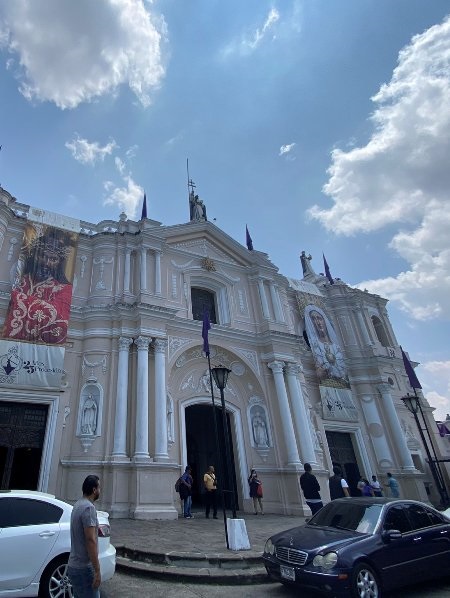
The Church of Santo Domingo, in Guatemala City (2023, March): It was built by the Dominicans when they moved their order here from Antigua.
The church and convent of St. Dominic, dedicated to the Virgin of the Rosary, was begun in 1788 and completed in 1808. The image of Our Lady of the Rosary, the work of unknown artists, was finished in 1592. Commissioned by Friar Lopez de Montoya, a Dominican priest, the statue was made completely of pure silver. There is a popular tradition that the Virgin Mary went out to travel through America and that the Child fell asleep when they reached Guatemala, which is why she stayed there. In 1821 the leaders of the independence movement proclaimed her Patroness of the new nation. October, the month dedicated to the rosary, is the most popular and important religious happening for the Guatemalan people and nation
.
The road to Dominican evangelization spreads on several centuries
In 1529, Friar Domingo de Betanzos and Father Mayorga left Mexico as they had been invited by Pedro de Alvarado to go to Santiago de los Caballeros de Guatemala (Antigua Guatemala), a Spanish town newly founded. There they established the first Dominican convent of Guatemala (the convent of Santo Domingo). For various reasons, the Dominicans left it rather quickly, but came back in 1535; Friar Bartolome de Las Casas and Friar Pedro de Angulo settled there in the town of Guatemala and live in the convent.
In 1545 the convent of Santa Maria del Rosario de Cahabón, Alta Verapaz, is founded; in 1567 is founded that of San Pablo de Rabinal, Baja Verapaz.
In 1551, the new Dominican province of San Vicente de Chiapas and Guatemala is recognized by the General Chapter meeting in Salamanca; this province encompasses the Mexican State of Chiapas, Guatemala, El Salvador and Nicaragua, where it had already established convents. Friar Tomas de la Torre is its first Provincial.
The creation of this new province allowed the development of the Dominican presence all over the territory. Many convents and churches were founded, institutions were put in place and major building sites were started. The Province of San Vicente had in Guatemala new convents, houses and churches, and in addition to those already mentioned, the new building sites of Cubulco, San Miguel Chicaj, Salamá, Tactic, San Pedro Carchá, Lanquίn, San Cristóbal, Cobán, San Jerónimo, El Chol and many others.
In 1811, the Province of San José de Chiapas secedes, with all the convents of the State of Chiapas. Guatemala and Salvador keep the name of Province of San Vicente until 1872 when the religious orders are prohibited. The Province then ceases to exist.
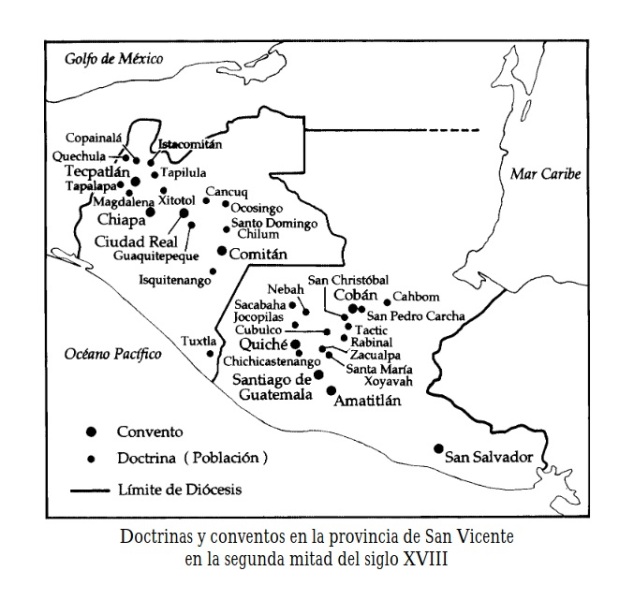
Convents and Doctrinas in the province of Saint Vincent of Chiapas and Guatemala, second half of the XVIIIth century (Christophe Belaubre, Poder y redes sociales en Centroamérica, el caso de la orden de los Dominicos, 1757-1829)
The beginnings of the road to Dominican evangelization
Friar Domingo de Betanzos establishes the first Dominican convent in Guatemala
"32. …At that time (1529), Don Pedro de Alvarado, Adelantado of Guatemala, was in Mexico and was getting ready to take his post as General Captain and Governor of the region. The men who were going to live in the town of Santiago (Antigua Guatemala) and Don Pedro asked Friar Domingo de Betanzos to come with them and to establish a convent of his own order, the only thing missing from their town to make it the second most important in the country after Mexico. The founding father, although he gave no importance to these mundane considerations, accepted to travel, fervently wishing to be of service to his order by creating a new convent, and wishing even more to serve God by bringing in the country faithful ministers of the Gospel. But since this good priest must travel by foot with only one companion, he refused to go with the horsemen. He got the agreement of the General Vicar in spite of the opposition from other religious authorities who did not want to do away with him; by his devout cries and the help of the prelate, the venerable elder was even able to leave with three of his spiritual sons to establish the religious province. He left Mexico very happy, even though he had to walk three hundred leagues, most of it through a very bad path that went up very steeply and full of rocks, going through uninhabited, desolate and lonely areas, and all the more unpleasant to cross by foot. In spite of this, he started his journey and reached the end of the road with much joy, convinced as he was to contribute somewhat, but not as much as he wanted, to spreading the Gospel which he followed in order to save souls.
"33. The father reached Guatemala and received a warm welcome in the town where his teachings were much appreciated. He did not even need to request a piece of land to build his convent, as Jorge de Alvarado, Deputy to the Governor, and the advisers and managers of the town offered him one, letting him choose the location, inside or outside of the walls, as he wished. And the father Friar Domingo picked and retained a land somewhat away from the dwellings, on the East, of a big enough size to build a church, the house and the garden; in all it measured no more than two acres so much so that the whole building felt narrow. The inhabitants provided ornaments for the church of the convent and furniture for the house which they quickly built, with a simplicity that the father judged necessary to show the example of poverty and humility to those whom he taught. He paid back the alms he received from the town with prayers, preaching and teaching."
(Friar Juan Bautista Méndez, Crónica de la provincial de Santiago de México de la Orden de Predicadores (1521-1564), Book One, Chapter 5, 1685)
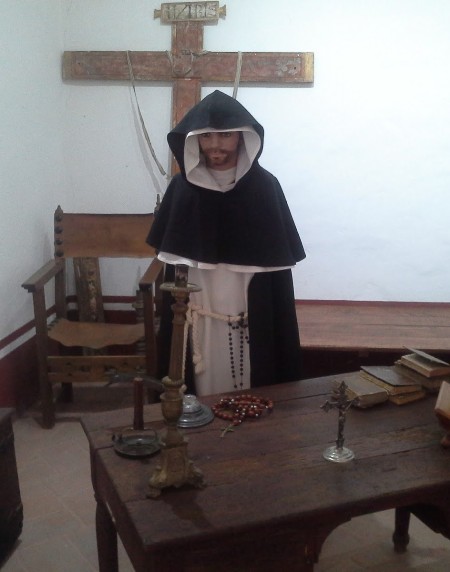
Domingo de Betanzos, "Museo del eremitorio de Fray Domingo de Betanzos", Tepetlaoxtoc, central Mexico
Bartolomé de las Casas leaves from that same convent to evangelize Verapaz
« 90 ; At the end of that year (1535) the fathers Friar Bartolomé de las Casas, Friar Luis Cáncer and Friar Pedro Angulo returned from Nicaragua to Guatemala to live in this convent which had been deserted long ago. Father Friar Rodrigo de Ladrada followed them soon after, arriving fro Peru. The whole town greeted them with pleasure, and more than anyone else, so did the bishop Don Fancisco Marroquín, whom our order looked upon as its father and who behaved as such. God had to be praised when one saw the humility with which the bishop taught declensions, conjugation, and the basic grammar of the Indigenous language of Guatemala to the Dominican priests, as he was very competent in that field. They themselves learnt it from such a master with ease and pleasure, thus becoming disciples to teach the language to others and help their dear pastor."
(Friar Juan Bautista Méndez, Crónica de la provincial de Santiago de México de la Orden de Predicadores (1521-1564), Book One, Chapter 13, 1685)
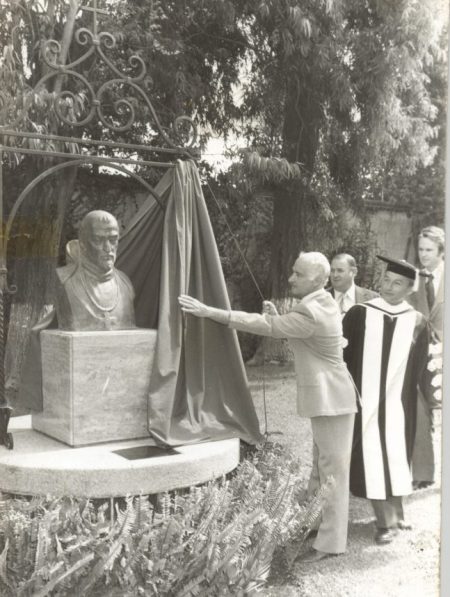
Inauguration of Francisco Marroquín' chest, first bishop of Guatemala, San Carlos University, Guatemala, 1975, January
«124. At the beginning of the year 1536, in Guatemala, the great man Friar Bartolomé de Las Casas planned (Remesal, book 3, chapter 15) to reach Tuzulutlán, land of war, now called Vera Paz, to conquer its souls, without any military help or warring violence, but on the contrary with the gentleness that Christ requested of his apostles: just like lambs among the wolves in order to make lambs of these wolves. With such a high aim, he entrusted himself to God’s mercy, which feeds and reaps all that is planted and gathered by His ministers.
(Friar Juan Bautista Méndez, Crónica de la provincia de Santiago de México de la Orden de Predicadores (1521-1564), Book Two, Chapter 1, 1685, translated by Chantal Burns)

The church of Cahabon, Verapaz
The convent was later abandoned
"147. ... Fr. Bartolomé de las Casas and Fr. Rodrigo de Ladrada returned to Vera Paz (1538) to continue the conversion of that province and see if they could enter further into the jurisdiction of Cobán, a mountainous and rugged land and the people less known than those of Rabinal... Their brothers who were in Guatemala called them, because of some good intentions with which the Bishop was so jealous of the good of his sheep... He (Bishop Marroquín) went on to ponder the great need of ministers that there was in New Spain for this, in view of such a copious and extensive harvest; and concluded that he would send for them to Spain for his bishopric, without anyone having the opportunity or power to prevent them from traveling, or to send them elsewhere... They resolved that Fr. Bartolomé would go to Spain for the religious, because of the great experience he had in the way of negotiating in the court, as he had done with success on other occasions... Those who were in the city of Santiago were divided in this way: Fathers Fr. Bartolomé de las Casas and Fr. Rodrigo de Ladrada decided to go to Spain and Fathers Fr. Luis Cáncer and Fr. Pedro de Angulo to the Chapter [of Mexico]...
"148. The house of Santo Domingo de Guatemala at this time was left alone and it was not a novelty at that time, because many other times the same thing happened, when all the fathers spread out through the region to preach and baptize the entire extended nation. They left in their care a Spaniard called Agustín de Salablanca, who later was the first to receive the habit of our Religion in that holy convent. In this situation, when there were no friars there, he went as if he were already there with vigilance to the building of the poor house, working hard to make adobes, which were the best materials of those times and in these times not at all safe for the repeated tremors of that earth."
(Fray Juan Bautista Méndez, Crónica de la provincia de Santiago de México de la Orden de Predicadores (1521-1564), libro segundo, capítulo 3, 1685)
Fray Juan Bautista Méndez: Born around 1645, he entered the Dominican Order at a very young age. In 1671 he became a lecturer in philosophy at the convent of Santo Domingo de México and received his doctorate in theology from the Royal University of Mexico. The Provincial Chapter of 1679 appointed him as the official Chronicler of the Province. In 1693 he was awarded a Master of Sacred Theology at the university chair of Santo Tomás. In 1699 he was prior of Santo Domingo de México. He died between 1703 and 1704. His "Crónica de la provincia de Santiago de México de la Orden de Predicadores (1521-1564)", written in 1685, was published for the first time in 1993 by Editorial Porrúa, in Mexico.
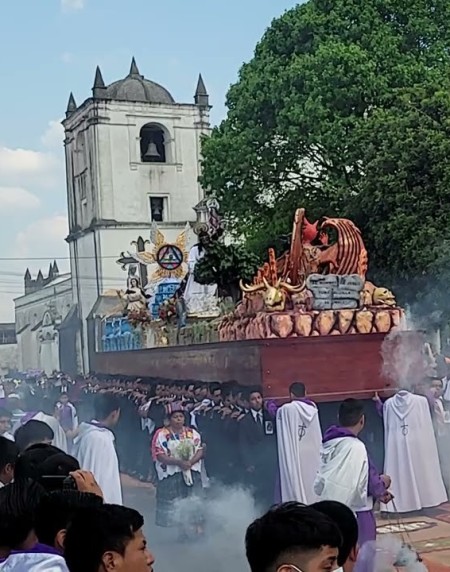
Coban: the procession of Palm Sunday, 2023, April
Cobán, 1574:
"The town of Saint Dominic of Cobán has, by the count of three years ago, 525 tributaries, of which 120 who came from Acala don’t pay tribute for they are very new and have unfidel relatives at the door, and so that they don’t flee as some have by being cowardly and being very new plants. This town is in a valley, and close to it on the south is a river that passes under three often rebuilt wooden bridges. The [river] frequently carries away these bridges. In the town are situated the monastery and convent of Lord Saint Dominic, with a capacity of twelve monks. Along with his church, these buildinds are of roughly worked stone. The monks built the church with some help from the adjacent towns, and the people of Cobán, with their quickness and great desire, have greatly helped with it. The doorway of the church is not yet finished. The vestry is half done because since the Indians of the town are so poor, there is very little they could give. What exists of a convent had to be acquired through the industry of the monks. The support of the monks comes principally by the gift of 300 pesos and maize from this town that His Magesty makes to them each year, and charity and other good works, but little charity given by the Indians. As is well known, it is not enough, but thanks to the help of the Lord Bishop, with all this we withstand need. We have asked for charity and support from His Magesty and again so request that it be so conceded. There are in this convent ten monks for four dependencies, but we need more for this very spread-out province."
(Report of the Province of the Verapaz made by the monks of Saint Dominic of Cobán, Friar Francisco Prior of Viana, Friar Lucas Gallego, and Friar Guillermo Cardenas on the 7th of December 1574, translated by Lawrence H. Feldman, in Lost Shores, Forgotten Peoples, Spanish explorations of the south east Maya lowlands, Duke University Press, 2000)
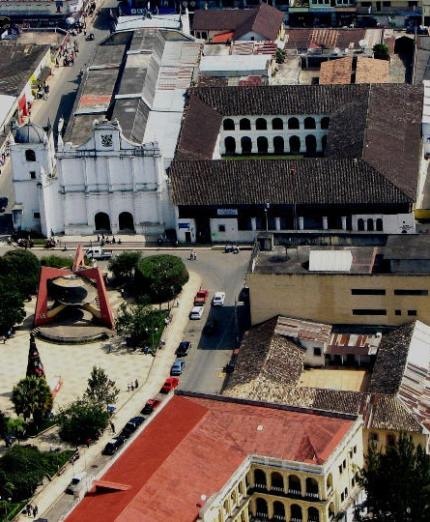
Cobán convent
"I came to Cobán by way of some good towns, some with 300 and 400 tributary households. Coming to the city of Cobán, which has more than 400 tributaries, it pleased me to see a good town for Indians, a splendid monastery, and a sumptuous church big enough for 2,000 persons to hear mass in, whose foundation we will discuss in its appropriate place.
"We gave a thousand thanks to the Lord on seeing the help and devotion given to the divine cult by the natives, and how well indoctrinated they have been by the friars of Saint Dominic (whose convent it was) who with enormous work and personal attendance, taught and catechised every day, filling the duties of priests of the souls according to the order they had from His Majesty, as we will discuss further on, and with the permission and order of their General. They have kept these Indians so firm in the faith and so constant that never since the beginnings of preaching of the Holy Gospel have they rebelled. Only in one group in this city, called San Marcos, did they martyr two religious of Saint Dominic on their lands, which are very close to those of the Lacandon. Even they said there were those who helped them. As we noted previously, those of this province are good Christians, and punctual in obedience to the Governor and the friars who administer it."
Don Martin Alonso Tovilla, Relación Histórica Descriptiva de las Provincias de la Verapaz y de la del Manché, 1635

Cobán, 2024, June, Latter-Days Saints Temple dedication. The Cobán Temple is the third built in Guatemala. The North American missionaries are learning Spanish and Q'eqchi
2025 "Friars and Mayas"
|


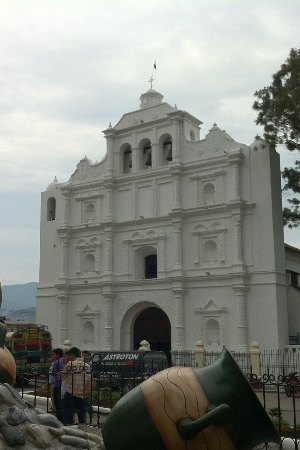
The church of Salamá. Located at the central plaza, it is a sample of the Spanish colonial architecture of the XVIIth Century. It boasts a Baroque façade, and its main navel and masonry dome have several Rococo carvings, gold laminates and paintings that depict scenes of the period.
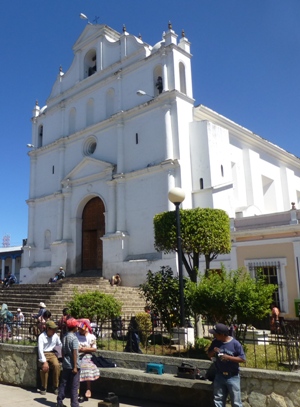
Santa Cruz del Quiché: On the central plaza, there's a large colonial church, built by the Dominicans with stone from the ruins of Utatlan. The Catholic church suffered terribly in El Quiche in the late 1970s and early 1980s, when priests were singled out and murdered for their connections with the co-operative movement.

Nebaj: The location of this hamlet, nestled in a valley among the Cuchumatanes mountain chain, is superb, with its quaint houses and its whitewashed church Santa María coming into view from the mountains above. The town is centered around the plaza with the church and government offices built around it. A peek inside Nebaj’s church reveals a multitude of small crosses as a memorial to civil war victims.

Lanquín, Alta Verapaz: Between 1,540 and 1,550, its first Catholic Church was built, with the name of San Agustin. This Church was destroyed by the flames of a fire that consumed the half of the population, for which a new one was built from the year 1,574. This new construction and by effects of an earthquake that shook the country around 1,810, lost a considerable part of its structure, for which was restructured without that part.

Chajul is a picturesque collection of quaint adobe houses with tiled roofs. Of the three Ixil Triangle towns, it certainly has the most traditional feel. The town’s Iglesia de San Gaspar Los Reyes has been restored with new front doors carved by local artists and is a major pilgrimage site on the second Friday of Lent for its Cristo de Golgotha.